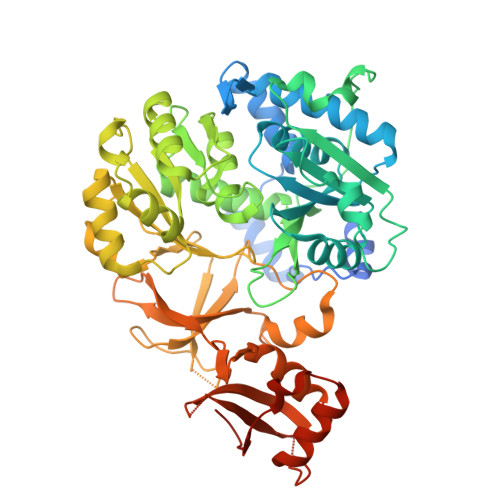Expanding the Substrate Selectivity of the Fimsbactin Biosynthetic Adenylation Domain, FbsH.
Ahmed, S.F., Balutowski, A., Yang, J., Wencewicz, T.A., Gulick, A.M.(2024) ACS Chem Biol 19: 2451-2461
- PubMed: 39513969
- DOI: https://doi.org/10.1021/acschembio.4c00512
- Primary Citation of Related Structures:
9BHY, 9BHZ - PubMed Abstract:
Nonribosomal peptide synthetases (NRPSs) produce diverse natural products including siderophores, chelating agents that many pathogenic bacteria produce to survive in low iron conditions. Engineering NRPSs to produce diverse siderophore analogs could lead to the generation of novel antibiotics and imaging agents that take advantage of this unique iron uptake system in bacteria. The highly pathogenic and antibiotic-resistant bacteria Acinetobacter baumannii produces fimsbactin, an unusual branched siderophore with iron-binding catechol groups bound to a serine or threonine side chain. To explore the substrate promiscuity of the assembly line enzymes, we report a structure-guided investigation of the stand-alone aryl adenylation enzyme FbsH. We report structures bound to its native substrate 2,3-dihydroxybenzoic acid (DHB) as well as an inhibitor that mimics the adenylate intermediate. We produced enzyme variants with an expanded binding pocket that are more tolerant for analogs containing a DHB C4 modification. Wild-type and mutant enzymes were then used in an in vitro reconstitution analysis to assess the production of analogs of the final product as well as several early stage intermediates. This analysis shows that some altered substrates progress down the fimsbactin assembly line to the downstream domains. However, analogs from alternate building blocks are produced at lower levels, indicating that selectivity exists in the downstream catalytic domains. These findings expand the substrate scope of producing condensation products between serine and aryl acids and identify the bottlenecks for chemoenzymatic production of fimsbactin analogs.
Organizational Affiliation:
Department of Structural Biology, University at Buffalo, Buffalo, New York 14203, United States.
















